
MAY CONTAIN NUTS

Search Shorpy
SHORPY ART

Framed or unframed, desk size to sofa size, printed by us in Arizona and Alabama since 2007. Explore now.
Join and Share
Ad-Free Shorpy
Shorpy is funded by you. Patreon contributors get an ad-free experience.
Learn more.

Recent comments
- Illuminate us
- I remember it well
- I can't prove it
- Complicated then, forgotten now
- Bryan-Stevenson
- Skinny is as skinny does
- How do you rest in peace
- Riding the footboards
- Alas, hidden from view
- Baldwin Diesels
- Exclusive pump
- Bananas, Oysters and Smokey Joe
- Details, Details
- What's that building to the left of the tower?
- Coal Barges
- Bromo-Seltzer
- Inner harbor
- The Basin
- What a headache!
- Giant stepladder?
- Yeah, it was cold
- Love those coats
- Link & Pin Days Remnant
- Baldwin 62303
- Baldwin VO-1000
- Cold
- No expense spared
- Tough Guys
- What's your hurry, where's your hat?
- Sheriff's Signature
Member Photos
The Shorpy
Print Emporium
Print Emporium
Search Shorpy
Search results -- 30 results per page
- Steichen Autochromes
- ... than Edward Steichen have come to light recently, the New York Times reports : "Almost as intriguing as the pictures themselves is ... story of how they recently made their way from a house in Buffalo, where they apparently sat unseen for decades, to the collection of the ... Posted by Dave - 08/07/2007 - 3:03am
- Dog Cakes: 1910
- Utica, New York, circa 1910. "United Commercial Travelers of America building." On a block ... Posted by Dave - 08/15/2012 - 3:06pm -
![Dog Cakes: 1910 Utica, New York, circa 1910. "United Commercial Travelers of America building." On a block offering a cornucopia of goods and services: Dog Cakes (not to be confused with Twentieth Century Lunch three doors down), dog collars, bananas, cigars, an amusement arcade (the Shooting Gallery), coal, shoes, trunks and, finally, crockery and glassware. 8x10 inch glass negative View full size.
Close to homeThis building is now an apartment complex, but most of the buildings to the right are gone, lost in a massive fire in 1948. Among them was my father-in-law's store, just out of the picture. If you could pan to the right, I'd appreciate it!
[Done. - Dave]
OK I'll BiteWhat's a dog cake?
What better to eat with Dog Cakes butDog Milk!
I took this photo of a can of Dog Milk that I saw in a Restaurant where I was dining in Japan a few years ago.
I asked the waitress how many dogs had to be milked to get a whole can of Dog Milk, but she didn't seem to understand.
70 Genesee StreetIn 1905, the company needed more office space and moved to this building, at 70 Genesee Street in downtown Utica, within sight of the Erie Canal.
In 1937, the building was tripled in size to accommodate the needs of more than 200,000 policyholders.
View Larger Map
The lunch is up to dateI'm reassured. If they advertised a 19th Century lunch, it would be ten years past its expiration date. Which is only four years past the Pure Food and Drug Act.
Kid-Free Eatery"20th Century Lunch -- For Ladies and Gentlemen"
Penny ArcadeThat's a great view of an old penny arcade, taken at a time when many of the attractions actually did cost only one cent. At the doorway is what appears to be a 44-note piano. These were usually set up to play a tune for a nickel, although the operator could have set it to play continuously as a means to entice passersby to enter. Along the right wall can be seen a row of Mutoscopes similar to the ones in the photo below. These played a moving picture supplied by individual frames printed on cards and formed into a reel. Each real contained one short movie, and since each Mutoscope held only one reel, the arcade would have many Mutoscopes in order to offer a variety of movies.
"Dog Cakes" - No dogs addedSpratts "Dog Cakes" was the first mass-produced dog food. James Spratt came up with "Patented Meat Fibrine Dog Cakes" after seeing dogs eating hardtack biscuits. The biscuits were initially marketed to country gentlemen in England for their hunting dogs.
Production was relatively limited until after James Spratt's death. However, in the 1880s, the company went public and became one of North America's marketed company in the 20th Century. They were eventually bought out by Purina.
Charles Crufts, who founded the Cruft's Dog Show began as a clerk for Spratt's.
Spratt was secretive about the actual meaty ingredient in his "cakes" and early ads in England intimated it was buffalo.
(The Gallery, Dogs, DPC, Stores & Markets, Utica)](https://www.shorpy.com/files/images/4a19575a.thumbnail.jpg)
- S.S. Utica: 1910
- Circa 1910. "Freighter S.S. Utica , New York Central and Hudson River Railroad Line." 8x10 inch glass negative, Detroit ... Utica, built in 1904 for the Western Transit Co. of Buffalo, N.Y. Gross tonnage: 3533, length: 325 ft., beam: 44 ft.
Hmmmm ... Posted by Dave - 08/14/2012 - 8:50pm -
![S.S. Utica: 1910 Circa 1910. "Freighter S.S. Utica, New York Central and Hudson River Railroad Line." 8x10 inch glass negative, Detroit Publishing Company. View full size.
1904-1949Constructed by the Detroit Ship Building Co., this 325-foot package freighter was launched April 28, 1904, at Wyandotte for the Western Transit Company, the marine operation of the New York Central on the Great Lakes.
In 1915 the Interstate Commerce Commission, citing the 1912 Panama Canal Act, ruled that American railroads could not also engage in marine transportation, and the NYC (as well as Erie, Pennsylvania, and Lehigh Valley) sold their steamship operations on the Great Lakes. Many of the vessels were consolidated under a new firm, Great Lakes Transit Corporation, for which the Utica ran from 1916 until 1945. That year, GLTC sold her to Chilean interests who renamed her Quintay. She was towed down the Chicago River, the Chicago Sanitary and Ship Canal, the Illinois River, and eventually the Mississippi to New Orleans.
The Quintay stranded and became a total loss on Penguin Island in the Messier Channel, Chile, on April 28, 1949, on a voyage from Callao to Punta Arenas while carrying general cargo and drums of oil.
Steamship Utica
Beeson's Marine Directory of the Northwestern Lakes, 1908
Steamship Utica, built in 1904 for the Western Transit Co. of Buffalo, N.Y. Gross tonnage: 3533, length: 325 ft., beam: 44 ft.
HmmmmI wonder what the three planks on the side of the hull are.
[Docking fenders. - Dave]
Rounding the Eastern Continent?I was not aware a vessel of this size could move South out of Lake Michigan and down thru to New Orleans in the canal/river system.
[As noted below, the Utica was a Great Lakes freighter. - Dave]
(The Gallery, Boats & Bridges, DPC)](https://www.shorpy.com/files/images/4a16007a.thumbnail.jpg)
- Capitol Refining: 1925
- ... be the only one of its kind east of Chicago and south of New York, and the only complete compound plant on the coast between New York ... an independent concern, whose main establishment is in Buffalo, N.Y., and its announced that about September 1, after extensive ... Posted by Dave - 09/11/2011 - 6:42pm -
![Capitol Refining: 1925 A glimpse at the industrial side of Washington circa 1925, labeled "Capitol Refining Co. plant." This tank farm, where the Pentagon stands today, was described at the time as being in "Relee, Alexandria County, just south of the highway bridge." National Photo Co. Collection glass negative. View full size.
OMG!I hate it when Giant Amoebas attack!
Cattle, Cotton & Oil, Oh My!I find it curious how this site evolved from a stockyard and abattoir (slaughterhouse) into a cottonseed oil refinery and then finally the petroleum refinery pictured. The cotton-seed oil may have been used for food or industrial applications such as lubricants and paint. I wonder if equipment for refining cottonseeds could be reused to refine petroleum?
[Were any of these petroleum tanks? - Dave]
Update: After seeing the later White Dome post, I am pondering if perhaps the "refining" refers only to vegetable and animal oils and not to petroleum products at all. I guess its my fossil-fuel-centric lifestyle that led me to the conclusion that this was a petroleum refinery - that and pre-conditioning due to the long series of photos of service stations on Shorpy.
Washington Post, Jun 5, 1908
Packing Plant For City
Washington's industries are to be increased here of a plant with an annual output valued at from $4,000,000 to $5,000,000. The company, to be known as the Columbia Cotton Oil and Provisions Corporation, proposes to absorb the Washington and Virginia Stock Yard and Abattoir Company and to enlarge the plant and add equipment, not only for slaughtering of cattle, but for the refining of crude cottonseed oil.
...
The proposed plant, it is said, will be the only one of its kind east of Chicago and south of New York, and the only complete compound plant on the coast between New York and Savannah.
...
The annual capacity, according to figures submitted to the manufactures committee of the Chamber of Commerce, will be 100,000 barrels of crude cotton-seed oil, 125,000 hogs, 10,000 cattle, and 25,000 sheep and calves which will be converted into lard, lard compound, lard substitute, cooking oils, lard stearine, oleo stearine, hams, bacon, sausage, canned meats, fertilizer, hides, and a variety of fresh cuts to be put on the market.
Washington Post, Jun 2, 1913
Refiners Buy Oil Plant
The Capitol Refining Company, which was recently granted a charter by the Virginia corporation commission, has purchased the plant of the Columbia Cotton Oil and Provisions Corporation, at Relee, near Arlington Junction, Alexandria county. The Capitol Refining Company is a subsidiary of the Jacob Dold Packing Company, an independent concern, whose main establishment is in Buffalo, N.Y., and its announced that about September 1, after extensive repairs to the plant, operations will be resumed.
Relee, Va.Is it possible that Relee stands for Robert E. Lee? His estate was nearby.
[You are correct. The use of Relee, Virginia, as a place name seems to have begun in 1909, with the establishment there of a post office, rail stop and telegraph office, all connected with the Columbia slaughterhouse and rendering plant in what used to be Alexandria County, at the current location of the Pentagon. By 1935, use of the name seems to have pretty much stopped. - Dave]
Washington Post, November 11, 1909
Finishing Big Plant
$450,000 Abattoir and Refinery Soon to Operate.
To Employ 200 Persons. Industry at Arlington Junction Will Help Virginians.
Within ten days the Columbia Cotton Oil and Provision Company will begin operation of its $450,000 plant, which has been building near Arlington Junction across the river for the last nine months, and will mark one of the greatest strides forward in the industrial development of Washington.
In the abattoir 4,000 hogs a week will be killed, and a strong demand will at once be created in Virginia and surrounding States for porkers. ... The cotton oil refinery and abattoir will be run in conjunction in the production of lard compound, which will be one of the most important outputs of the establishment.
... The plant essays the importance of a town which has been recognized already by the establishment of a railroad stop and a postoffice by the United States government. The name is Relee, in honor of R.E. Lee. It is Relee postoffice, Relee station, and Relee telegraph office, all of which are in operation.
Day of JudgmentCould the "accidental" location of the "cloud" be any better placed in terms of composition? Actually makes the shot better, I think.
(The Gallery, D.C., Natl Photo, Railroads)](https://www.shorpy.com/files/images/32665u.thumbnail.jpg)
- All-American: 1942
- August 1942. New York. "Dancing and music on Mott Street at a flag raising ceremony in honor of ... John Basilone, an Italian-American from New York, although Buffalo, would be awarded the Medal of Honor for his actions during the Battle ... Posted by Dave - 04/24/2013 - 9:30pm -
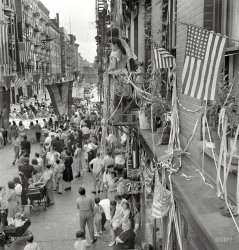
- Place d'Armes: 1916
- ... just make out part of the clock tower -- was built by the New York Life Insurance Company in 1887 and at 8 floors was the tallest building in ... Posted by Dave - 01/22/2018 - 9:37am -
![Place d'Armes: 1916 Circa 1916. "Place d'Armes and Notre Dame Cathedral, Montreal, Quebec." 8x10 inch dry plate glass negative, Detroit Publishing Company. View full size.
Place d'ArmesThe statue, lower center, erected in 1895, is of the founder of Montreal, Paul de Chomedey, Sieur de Maisonneuve. On the nearby Bank of Montreal is a plaque which reads: "Near this square afterwards named La Place d’Armes the founders of Ville-Marie first encountered the Iroquois whom they defeated, Paul de Chomedey de Maisonneuve killing the chief with his own hands. March 1644.” At the base of the monument itself is another plaque with a more shocking message by de Maisonneuve: "Il est de mon honneur d'accomplir ma mission. Tous les arbres de l'île de Montréal devraient-ils se changer en autant d'Iroquois." Which translates: "Upon my honour I am bound to accomplish my mission; even if all of Montreal’s trees should transform into as many Iroquois."
Great Old StuffThe building slightly visible on the extreme left -- you can just make out part of the clock tower -- was built by the New York Life Insurance Company in 1887 and at 8 floors was the tallest building in Montreal when it opened. The building next to Notre Dame is the Saint-Sulpice Seminary, part of which dates back to 1684. And in the middle of the square we find the statue of Paul Chomedy de Maisonneuve erected in 1895. All of these, and much more, are still there.
BasilicaAt the time it was built there weren't very many stone-carvers in Montréal, so the decoration is a bit plain. These days the cathedral is Mary, Queen of the World, which is a short distance away.
Radio or Lightning?Given the year, I am assuming the towers on top of the spires are lightning rods, not radio towers. Eh?
[Wireless telegraphy masts started being placed atop tall urban buildings before the turn of the century. -tterrace]
A striking differenceExcept for the addition of a small Art Deco highrise to the left and a massive 1960s block on the right, Place d'Armes has been preserved pretty well. But there's been one striking addition: the the concrete pavement of this photo has long since been replaced by cobblestones, in order to bolster the square's quaintness. Nowadays it's a cliche to rave at how "European" Place d'Armes looks.
It's a bit sad to contrast this view with some of the other photoscapes you see on Shorpy, especially of cities such as Cleveland and Buffalo. A hundred years ago the cityscapes weren't that different. I would argue that a lot of the American cities were even more fantastic than Place d'Armes. The trajectories of these cities echoed each other - although Montreal hasn't had the same economic trouble as the Midwest, this area of the city also fell into hard times and was pretty decrepit during the mid-century. But the revitalizers in the Midwest and Montreal had different ideas, and that's made the difference. In Montreal, they installed cobblestones; in Buffalo they built parking lots, and their former downtown is almost abandoned.
(The Gallery, DPC, Streetcars)](https://www.shorpy.com/files/images/SHORPY-4a24892a.thumbnail.jpg)
- Family Gathering: 1967
- ... apron. Mom is the second from the right. This was in Buffalo, New York. View full size.
Color correction I took a stab at it.
If ... Posted by billybobtoo - 02/01/2011 - 10:37am -
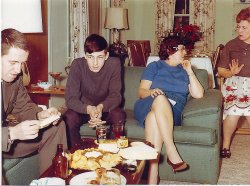
- Welcome, Wagon: 1919
- ... display window, it's beginning to look a little like New Year's. View full size.
Mystery hardware I can usually identify ...
Cross-Country Atterbury trucks were made in Buffalo, New York.
Automobile Row again Earle C. Anthony's REO and Dort ... Posted by Dave - 08/05/2016 - 9:57pm -
![Welcome, Wagon: 1919 San Francisco circa 1919. "Bus" is all it says on the sleeve of this 5x7 glass negative showing a motor home on an Atterbury truck chassis. In the Firestone display window, it's beginning to look a little like New Year's. View full size.
Mystery hardwareI can usually identify most components of early automobiles, but those vertical cylinders which appear to be attached to the forward end of the front springs have me baffled.
Some sort of primordial air suspension or shock absorber??
Shock absorbers, probably by Gruss, as seen and commented on in this photo. -tterrace]
Cross-CountryAtterbury trucks were made in Buffalo, New York.
Automobile Row againEarle C. Anthony's REO and Dort dealership was at 1400 Van Ness Ave., with Firestone Tire & Rubber (F.C. Flickinger, manager) next door at 1414.
San Francisco Planning Commission on 1400 Van Ness: "This is a fine restrained Classical Revival auto showroom with a rusticated base and Corinthian pilasters. The bay and pilaster width relate to the width of the street, with the Van Ness facade having a larger scale than the Bush facade. Because of the building’s corner location it would be difficult to alter or add to without significantly harming its integrity; therefore the building should remain intact."
The PalaceAlmost certainly, the gentleman standing just to the right of the driver's door is Arthur M. Neal (1869 - 1938) who built this traveling home for himself and his wife Fannie I. Neal (1871 - 1965). Having been the proprietor of the Hotel Arthur (1911-1912) and the Hotel Yale (1913 - 1919) in San Diego, he knew what accommodations were needed when traveling away from home. They nicknamed their vehicle "The Palace." The San Diego commercial automobile body firm of Klersy & Caldwell provided assistance with the build of the motorhome which was painted brown. Based on California vehicle registrations, the Atterbury was used by the New Southern Hotel as a bus prior to the Neal's ownership. It is likely a Model D built circa 1914.
Newspaper articles start appearing with photos of their mobile home in October, 1919, but the couple stated in the Roseburg [Oregon] Review, on October 3rd, that they had been on the road for eight months already. All of the earliest newspaper photos of their caravan do not show the Gruss shock absorbers installed, leading me to wonder if perhaps the Firestone dealer installed the devices for the Neal's. After visiting San Francisco their intent was to head east for a year.
The article below, from the magazine "Sunset," published in June 1920, describes more about their vehicle and the Neal's extended travels. This article is the last published piece I found about their excursion. The pair returned to San Diego later in 1920 or early 1921 where they became the managers of an apartment building at 1313 24th Street until Arthur Neal passed away in 1938. Fannie Neal continued residing there until just after WWII, but, even after leaving this apartment, she remained in San Diego for the rest of her life. She died at the age of 93 in 1965.
(The Gallery, Cars, Trucks, Buses, Chris Helin, San Francisco)](https://www.shorpy.com/files/images/SHORPY-1013.thumbnail.jpg)
- International Bridge: 1910
- ... Circa 1910. "International Bridge over Niagara River at Buffalo, New York." 8x10 inch dry plate glass negative, Detroit Publishing Company. ... Posted by Dave - 08/21/2013 - 9:31am -
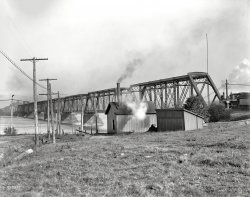
- Photo Shoot: 1974
- ... morning photo shoot with 3 friends on the back streets of Buffalo, New York. Buffalo's old buildings, train stations and docks were a popular ... Posted by gblawson - 10/12/2011 - 11:26am -
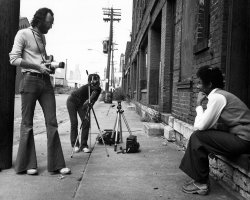
- Charlotte Edith Anderson (Monture)
- ... train an "Indian". She applied and was accepted at the New Rochelle Hospital, in New York, and trained there as a nurse, becoming a school nurse. When the Americans ... Posted by Mudhooks - 11/05/2011 - 11:00am -
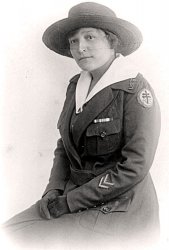
- Erie County Savings Bank (Colorized)
- Buffalo, New York, circa 1908. "Erie County Savings Bank, Niagara Street." 8x10 inch dry ... Posted by kdtop - 09/20/2010 - 8:06am -
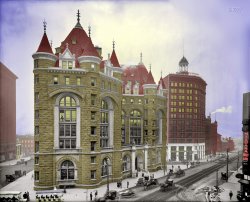
- The Wolak Family: c. 1921
- ... Helen Wolak, shown here in this circa 1921 photo taken in Buffalo, New York, with their five children (L to R), Bill, Stanley, Jenny, Marcel, and ... Posted by Art - 02/10/2010 - 5:47pm -
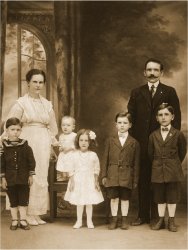
- Watch the Birdie: 1957
- ... 1957 Kodachromes. Taken in my grandparents' yard, Hamburg, New York (south of Buffalo). My grandfather owned a lot of land and had to mow a ... Posted by MarkN - 01/25/2013 - 8:08pm -
























